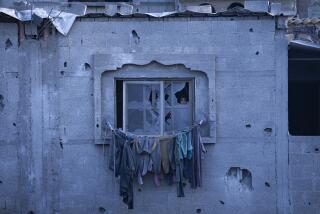More than 3,000 Yazidis still missing after collapse of Islamic State’s self-styled caliphate
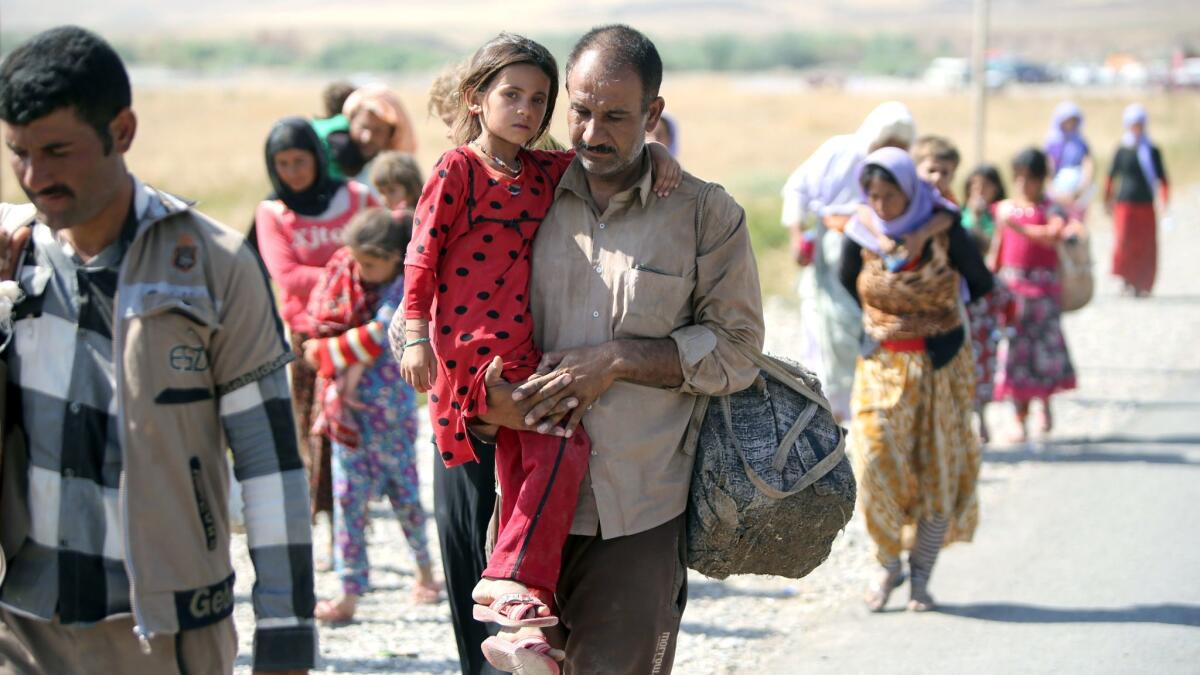
- Share via
Reporting from Baadra, Iraq — Kept as a slave by Islamic State militants, the mother prayed for her rescue and made a promise to God: If she ever saw her 10 children again, she would fast for three months to demonstrate her gratitude.
Her prayers were partially answered. In September, as the militants were being driven from their last strongholds in Iraq and Syria, she was freed and reunited with four daughters and a son. Her daylight fast has now come to an end.
But five other sons, along with her husband, are still missing.
“I honestly don’t know what hope is anymore,” said the woman, who asked to be identified only by her first name, Seve, so as not to endanger family members who might still be held captive. “There are very few places that haven’t been liberated, and my children still aren’t back.”
Her family belongs to Iraq’s Yazidi minority, followers of an ancient faith linked to Zoroastrianism that was targeted as heretical by the militants who overran its heartland near Mt. Sinjar in August 2014.
Thousands of Yazidi men and teenage boys were killed, while more than 6,000 women and children were taken captive. Sold at slave markets or gifted between fighters, they were passed from owner to owner like chattel across Islamic State-held lands in Iraq and Syria. Girls as young as 9 were pressed into domestic and sexual servitude, and boys were indoctrinated and trained as fighters or suicide bombers.
The collapse of the militants’ self-professed caliphate over the course of this year raised hopes for family reunions. But, according to a tally kept by authorities in Iraq’s semiautonomous Kurdish zone, as of late December barely half of those taken captive had been freed or managed to escape.
Now that major combat operations against Islamic State have been declared over in Iraq and Syria, Yazidi activists fear that the world’s attention has moved on and that the same powers they accuse of failing to avert a genocide three years ago have again forsaken their people.
“There is no one asking about the fate of more than 3,000 people,” said Ahmed Khudida Burjus, deputy executive director of the U.S.-based advocacy group Yazda. “We were expecting that the international community would do more to help save our community from extinction.”
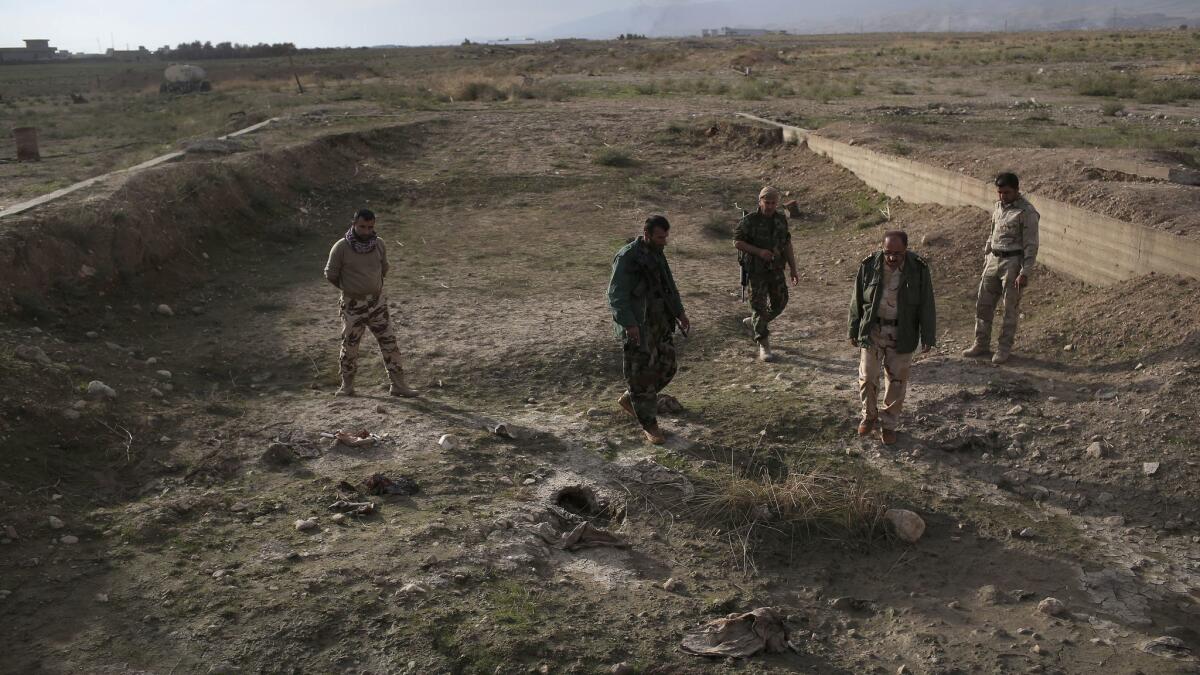
Human rights activists fear that many of the missing are dead — killed by their captors, used as suicide bombers or fighters, or caught in the crossfire as Islamic State battled local forces backed by U.S. and Russian air power. Cities such as Raqqah in Syria and Mosul in Iraq were pummeled for months, leaving neighborhoods in ruins.
But Yazidi activists — including smugglers who have pulled off hundreds of daring rescues — are convinced that others are still being held by Islamic State fighters or their families.
As cities came under assault, the militants often moved their families and household slaves to areas they still controlled. There were also captive Yazidis mixed in with the tens of thousands of civilians who fled the fighting.
::
Khaleel Aldakhi believes hundreds could still be alive — and he’s trying to find them.
A lawyer married to a former member of the the Iraqi parliament, he used his extensive contacts to set up one of several Yazidi rescue networks that operate out of the northern Iraqi city of Dahuk.
His collaborators would find opportune moments — often when the militants were at prayer — to sneak away with their captives. Those who were caught were beheaded.
The job became more difficult as Islamic State lost its territory and militants went underground. But Aldakhi said his network still averages two or three rescues a week, many of them captives brought to Syria by fighters driven out of Iraq. A few wound up in Turkey with Islamic State families.
On a recent evening, Aldakhi was drinking tea at a local cafe when his cellphone lit up. It was a WhatsApp message from a Sudanese fighter who was holding a teenage Yazidi girl in the northwestern Syrian province of Idlib.
The fighter wanted to sell the girl back to her family so he could use the money to escape to Turkey. “If you swear to Allah that you won’t give my information to anyone, I will bring the Yazidi girl out,” he wrote in Arabic.
Aldakhi gave his word, then laughed. He is Yazidi himself and wasn’t bothered about an oath to Allah. His only concern was for the man’s captive.
He called a contact in Syria and told him to do whatever it would take to get the girl into territory held by Kurdish militias — the United States’ principal ally in northern Syria in the fight against Islamic State.
“Do it tonight. What happens to the Daesh guy, I don’t care,” Aldakhi said, using a derisive term in Arabic for Islamic State.
He is still waiting for word about whether the girl was rescued.

Zedan, 10, was captured with his grandmother after their car crashed while trying to escape the fighters who attacked their village. Relatives assumed both were killed.
That same morning, he had delivered a 10-year-old boy named Zedan to his parents at a camp for displaced Yazidis outside Dahuk.
Zedan was captured with his grandmother after their car crashed as they tried to escape the fighters who attacked their village. Relatives assumed both were killed. But a year later, Zedan’s father received a furtive call from a captive relative who had seen the boy with an Islamic State family in the Iraqi city of Tall Afar.
The father, Khalaf Khodeida, met with government officials and aid groups, and he reached out to activists like Aldakhi with contacts behind Islamic State lines. No one could locate the boy.
News of Tall Afar’s capture by Iraqi forces in August revived his hopes, but there was still no word of Zedan. Then on Nov. 4, Khodeida received a text message from a stranger offering to return Zedan if someone could come pick him up in Syria.
It turned out Zedan’s captors had taken him to the town of Mayadeen, one of Islamic State’s last refuges there. The man who called was a neighbor who took pity on the unkempt little boy he saw running barefoot in the street and somehow managed to spirit him away from his captors.
Zedan couldn’t remember his parents’ names or where they were from. So the neighbor shared pictures of the boy on social media, hoping someone would recognize him. That’s how he eventually got Khodeida’s number.
“We thought our son was dead,” Khodeida said, “and now he has been reborn.”
Aldakhi recorded video of the reunion on his phone. In the clips, relatives crowd around Zedan, offering candy and kisses. The shy little boy in a green-and-gray hoodie appears confused. He no longer understands his native Kurdish, only the languages of his captors, Turkmen and a little Arabic.
He is led to an elderly man sitting on a plastic chair: his grandfather. The man embraces the boy four times and starts to cry.
“The grandfather told me I have only one wish, to see my grandson before I die,” Aldakhi said. “I got his wish done.”
::
Tales like these sustain Seve as she waits for news of her children.
She lives in a sparsely furnished house lent by fellow Yazidis in the village of Baadra, near Dahuk, in Iraq’s northern Kurdish zone. Her own home, in the farming community of Hardan, was destroyed by an airstrike after Islamic State took over the Sinjar region.
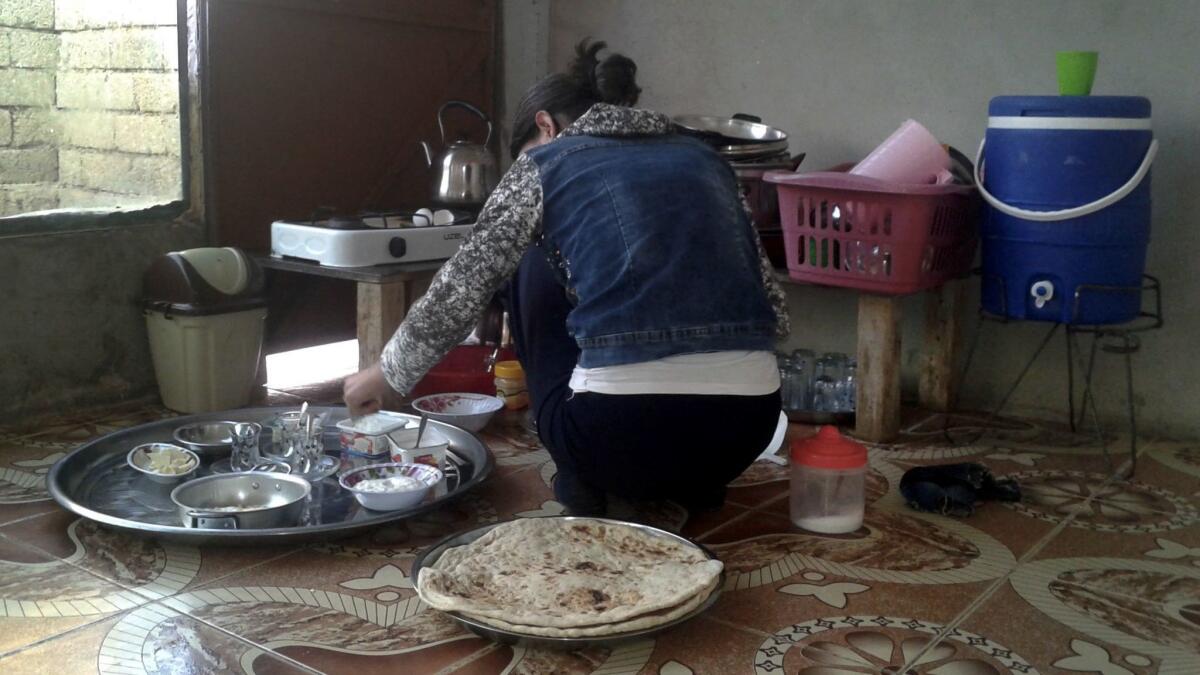
Seve’s eldest daughter, who is married and lived in another village, managed to escape the militants, joining a massive exodus to the Dahuk region, to the north. But fighters took Seve’s husband and two adult sons at gunpoint. Seve and the rest of her family were bused from one crowded prison to the next, where they were starved and beaten until they were sold off.
Three daughters — 19, 17 and 13 at the time — were the first to be dragged away. Then her mother-in-law, daughter-in-law and newborn grandson. Seve and the four boys, ages 5 to 12, were sold to a Saudi Arabian fighter who brought them to his 19-year-old sister and her husband in Mosul as domestic help.
The young woman told Seve she considered the boys like her own. If one of them wanted potato chips, Seve said, the woman, who never left home unarmed, would pick up her rifle and go buy chips.
“Daesh was very, very bad,” Seve said. “But there were some who were better than others.”
But the couple also told the boys that their parents were infidels; they forced the family to memorize passages from the Koran and pray five times a day.
When Seve was told the two older boys were going to be enrolled in a “military institute,” she cried for days. She knew if her sons learned to handle weapons, they would be forced to fight.
After about six months, the couple sold Seve and the boys to another family who could not afford to keep them together. They took photographs of the children and posted them at checkpoints and military bases, until one by one, they were sold off.
The youngest, Saidou, was 6 when he was taken from Seve, who screamed and threatened to kill herself. The slave trader just laughed.
She eventually ended up cooking and cleaning for a couple in Raqqah, Islamic State’s would-be capital in Syria. When that city came under assault, they brought her to Mayadeen. When it looked like Mayadeen too would fall, the couple decided to sell her back to her family.
They demanded $17,000, far more than Seve thought her relatives could afford. But they went door-to-door until they had raised the money. Smugglers were enlisted to drive Seve to a nearby village, where she caught a ride with civilians who were fleeing to Kurdish territory. A brother and other relatives picked her up from there.
To Seve’s amazement, Saidou was with them in the car. His captors had sold him back to the family for $10,000 last year. Two daughters had also been rescued, found by Iraqi forces after being abandoned during the fighting in Mosul. But the family had to borrow more than $30,000 to smuggle Seve’s mother-in-law, daughter-in-law, grandson and another daughter out of Islamic State territory.
The Kurdish regional government reimbursed most of the family’s expenses. But it is in the midst of a financial crisis and has not yet reimbursed anything for Seve’s rescue. She wonders how her family will repay their creditors or rebuild their lives.
“If I had my boys back, they would do something for us, but I don’t know if they’re still alive,” she said, fighting back tears. “The world doesn’t make sense if your children aren’t around you.”
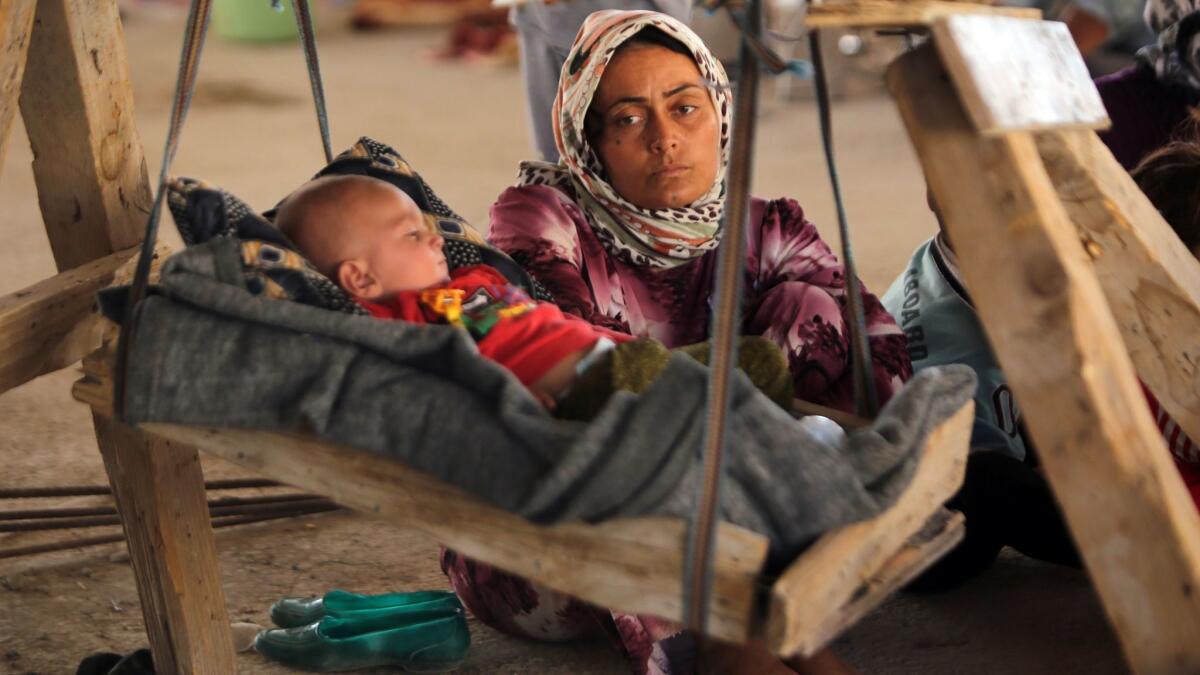
This article was reported with a grant from the United Nations Foundation.
Special correspondent Bawar Ihsan contributed reporting from Dahuk, Iraq.
Twitter: @alexzavis
More to Read
Sign up for Essential California
The most important California stories and recommendations in your inbox every morning.
You may occasionally receive promotional content from the Los Angeles Times.


